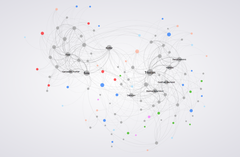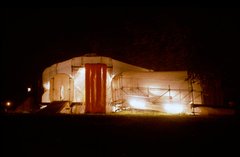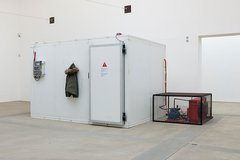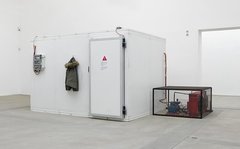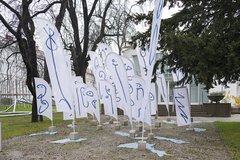A tour through the exhibition „trigon 67/17: ambiente nuovo / post environment“
On View: „trigon 67/17: ambiente nuovo / post environment“
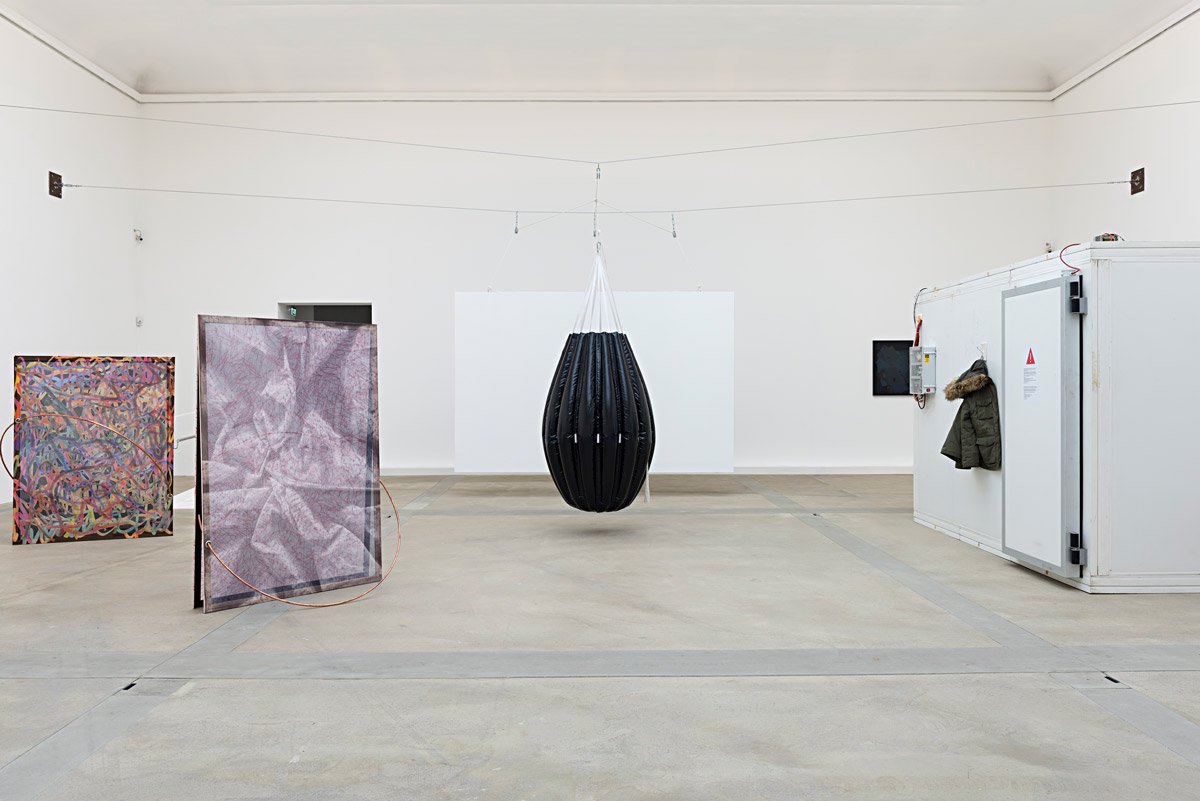
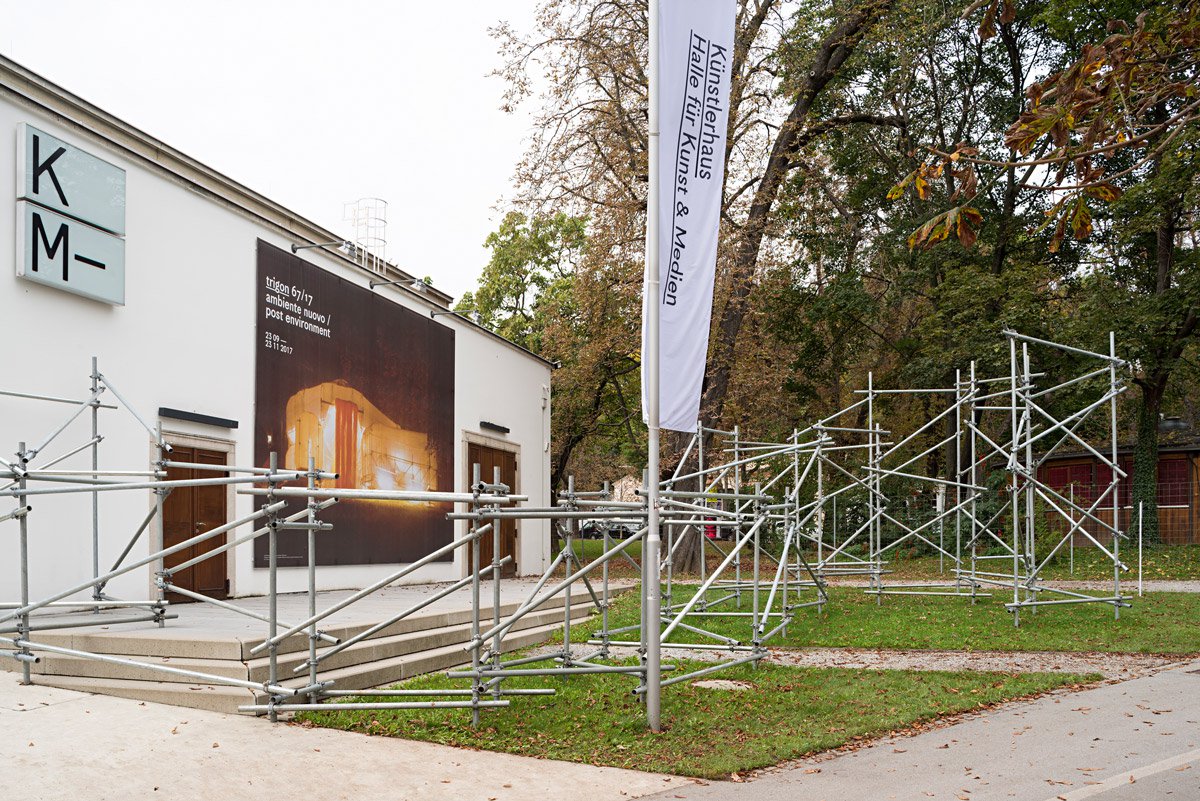
Eilfried Huth, Entry structure and fence trigon 67/17, 2017
Scaffolding, fence, dimensions variable
Commissioned by Künstlerhaus –Halle für Kunst & Medien
In 1967, the “Planungsgruppe Domenig/Huth,” consisting of Günther Domenig (*1934 Klagenfurt– 2012 Graz) and Eilfried Huth (*1930 Pengalengan, lives in Graz), was commissioned to design the exhibition parcours of trigon 67. The young architects, now known as representatives of the renowned “Grazer Schule,” had caused a sensation one year prior to the exhibition with their design of a building in Ragnitztal. Their utopian concept for a vertically stacked, housing complex radically opposedthe then common ideas of urban planning. The client ended up cancelling the project, called “Neue Wohnform Ragnitz” (New form of living Ragnitz), but Domenig and Huth continued to develop their ideas. For trigon 67, Domenig and Huth designed the “exhibition transformer,” a spiral-shaped, entry complex inside of a dome with an unusual form, in which the viewer had to follow a predetermined path. This was meant to prepare the viewer for the exhibition ahead.
As a reference to the concept from 1967, Eilfried Huth has again designed an entry situation, taking recourse to the then current ideas of the curve as a building form. The architect has also conceptualized the fence, protecting the exterior exhibition area. From a bird’s eye view, the fence somewhat resembles a continent (Africa) and stems from the architects concern about populist impulses in regards to questions of the use and distribution of space, as well as migration.
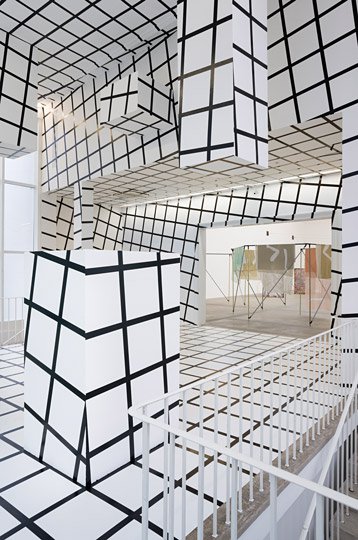
Esther Stocker, Untitled, 2017
Adhesive film on wall, cubes, desks, dimensions variable
Commissioned by Künstlerhaus – Halle für Kunst & Medien
Courtesy the artist
photo: Markus Krottendorfer
The artist Esther Stocker (*1974 Schlanders, Südtirol / Alto Adige, lives in Vienna) covers surfaces with geometric, serial patterns and grid structures, creating immersive, site-specific installations that react to the architectural conditions of the exhibition space. By adding unexpected but decisive breaks in her geometric patterns, the works expose the phenomena of sight. For instance, walls seem to lean, while perspectival breaks blur spatial limits. The foundation of the artist’s practice lies in traditions of abstract painting and Russian constructivism. In the Künstlerhaus’ foyer, Stocker has covered the walls and larges cubes with black lines, creating an all-encompassing installation that challenges our perception of three-dimensionality. Furthermore, the architectural grid of the foyer’s windows produce a generative relationship between the architecture and the work.
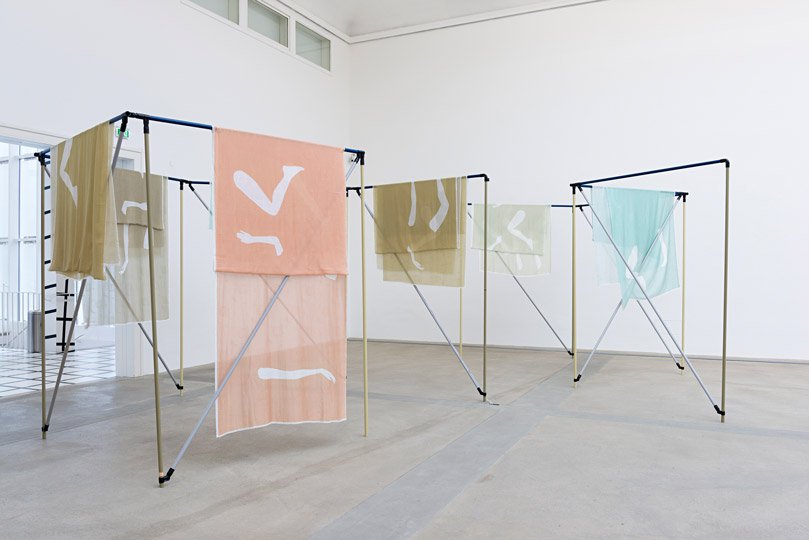
Tina Gverović, Diamond Cuts: Sea of People, 2016
Metal pipes, silks, sound, dimensions variable; Collaboration with Ben Cain, Audio by Alexis Taylor
Courtesy the artists and Johann Jacobs Museum, Zurich
photo: Markus Krottendorfer
In her immersive, spatially adaptable installations, the Croatian artist Tina Gverović (*1975 Zagreb, lives in London and Dubrovnik) investigates space, territory, and identity. Although there are distinct political connotations, invention and imagination play a large role in the artist’s practice; the choice of materials and the employment of sound and text have a strong poetic quality. The installation Diamond Cuts: Sea of People, comprised of cloth banners strewn with printed limbs and thin metal rods, refers to a contemporary concept of human being: fragmented, in constant flux, flexible, and variable. The elegant and filigree construction of this threedimensional drawing in space builds the base structure for further inquiries into acute questions of voluntary and forced migration, displacement, reunification, and reunion. Presented within and outside of the Künstlerhaus, Gverović uses song and text to address separation in terms of content and the physical, spatial separation between the interior and exterior of the exhibition space.
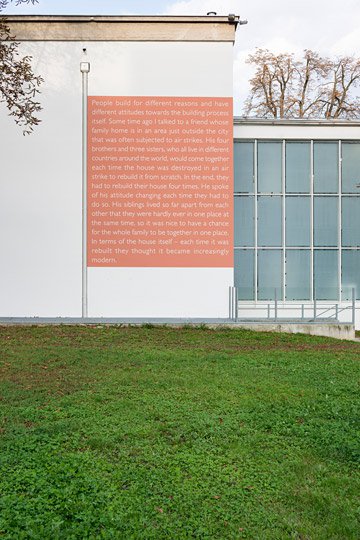
Tina Gverović, Open Air, 2017
Dispersion paint, wall, dimensions variable; Collaboration with Ben Cain; Commissioned by Künstlerhaus – Halle für Kunst & Medien
Courtesy the artists
photo: Markus Krottendorfer
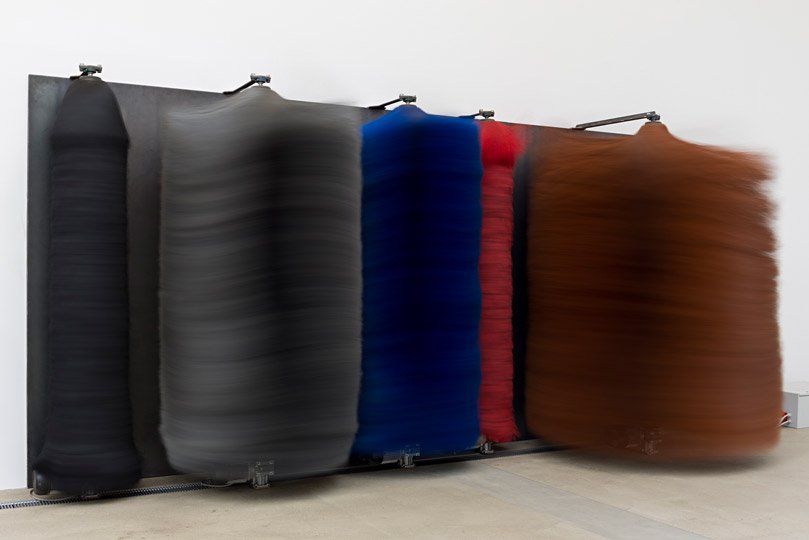
Lara Favaretto, Gummo V, 2012
Car wash brushes, iron slabs, motors, electrical box, wires, 250 x 500 x 190 cm, overall dimensions variable in time
Courtesy Fondazione Sandretto Re Rebaudengo
photo: Markus Krottendorfer
Lara Favaretto’s (*1973 Treviso, lives in Turin) installations and sculptural works grapple with ideas of monumentality and change. Within this context, Favaretto examines conditions of failure, disappearance, and uselessness, considering them to be generative and positive processes. Another important aspect in her work is the relationship between sculpture and time. Named after a film by Harmony Korine, the Gummo-series showcases voluminous, different colored brushes (like the ones used at the car wash) produced by a supplier specifically for the artist. In rotation, the brushes turn into visual fields, bringing out a painterly dimension, and their continuous movement sets their surroundings in motion as well. The friction of the metal base plates, to which the brushes are fastened, has a paradox effect, counteracting the original function: An electromagnetic field emerges around the base, attracting dust and dirt instead of repelling it. Therefore, for the duration of the exhibition, it is prohibited to clean the area around the work.
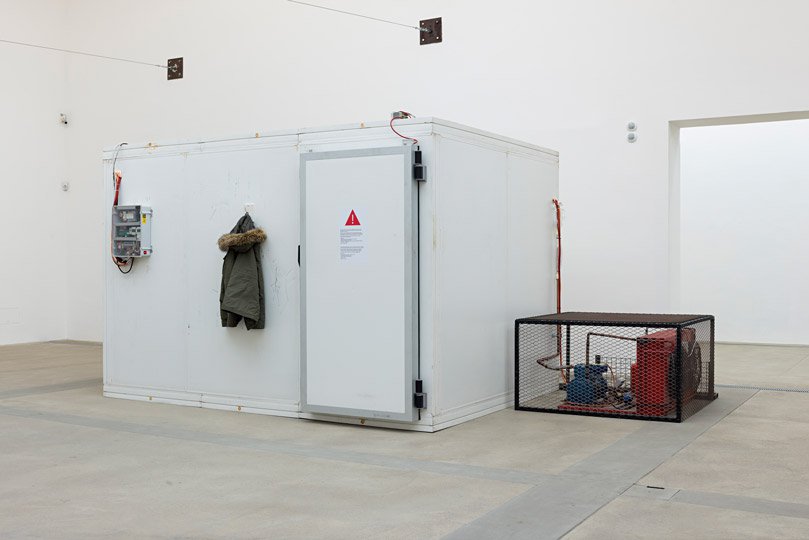
Micol Assaël, Vorkuta, 2003
Walk-in cold storage cell, switchboard, chair with electric resistor, thermostat, sparks, 210 x 220 x 350 cm
Courtesy Collection Sandra and Giancarlo Bonollo, Italy
photo: Markus Krottendorfer
Micol Assaël (*1979 Rome, lives in Astypalea) creates environments, with technical devices, immersive spaces that enable intense experiences. At the center of the artist’s practice, geared toward sensual and cognitive perception, she confronts the human body with electrically generated energy fields, magnetism, or natural phenomena such as extreme cold. References to bygone and outdated scientific theories are just as important to the artist as the tension between visible and invisible forces. Despite the poetic qualities of her work, Assaël’s radical application of technology elicits feelings of anxiety and danger. Vorkuta, created in 2001 and 2003, belongs to the artist’s earliest work in which she examines physical and electrical phenomena. The work is named after a Russian labor camp in the arctic circle, a place where temperatures drop as low as -60° Celsius.
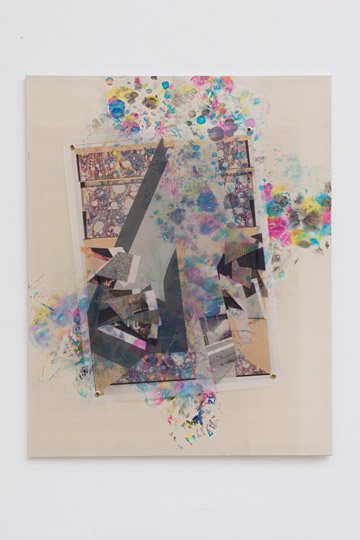
Jelena Trivić, Tausendflügler, 2012
Ink, foil, wallpaper glue on canvas, 150 x 120 cm
Courtesy the artist
photo: Markus Krottendorfer
Jelena Trivić (*1980 Ludwigshafen, lives in Berlin) artistic practice is based on the combination and expansion of painterly means, printing methods, and techniques found in the field of applied arts. In accordance with the traditions in which it developed, the artist primarily uses collage, cutting and pasting images and textual elements on canvas, whereby the choice of material is markedly contemporary. Trivić incorporates fabrics that have been used to clean the printing heads in copy shops, as well as printed plastic sheets punctured and attached with metal eyelets. The artist also generates digital collages by scanning patterns and subsequently arranging them on screen. In some cases, these untitled works are placed upright in the space; printed on polyester and spanned on canvasframes that are stablized by copper rings, they become free-standing sculptures. In addition, Trivić has produced a pinstripe portrait of the track and field athlete Dick Fosbury (*1947 Portland, lives in Ketchum) for trigon 67/17, who revolutionized high jump with his Fosbury flop.
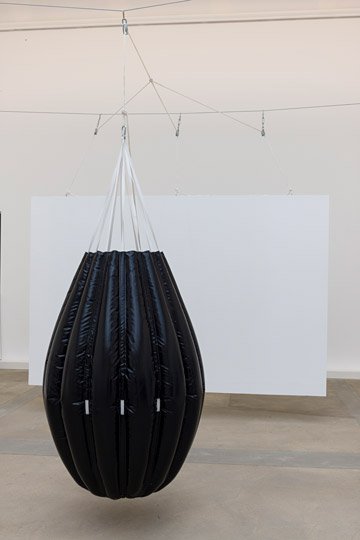
Sonia Leimer, Instabil auf Unstabil, 2015
Wood, plywood, latex paint, rope, steel cable, PVC tarp, water, dimensions variable
Courtesy the artist and Galerie nächst St. Stephan Rosemarie Schwarzwälder, Vienna
photo: Markus Krottendorfer
Sonia Leimer’s (*1977 Meran, lives in Vienna) artistic practice focuses on the construction of reality through the investigation of the categories space and time. Leimer has a conceptual approach, combining sculptural, architectural, and filmic elements. Because questions of how art is perceived within the exhibitionm space are so central in Leimer’s work, she pays close attention to the material used in each piece. The installation Instabil auf Unstabil (Instable on Unstable), in which a water-filled PVC balloon holds up a hovering wall of the same weight, addresses a precarious co-dependency: the constellation’s temporary stability is in constant danger of being toppled—by i.e. processes of evaporation—throwing everything off balance. The Künstlerhaus’ walls must hold the full weight of this work and could therefore, metaphorically speaking, be understood politically as a reference to the dependencies within the art world.
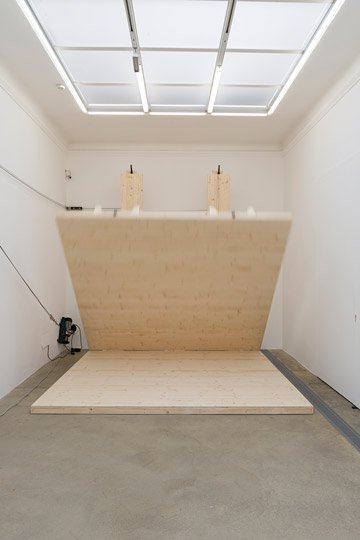
Max Frey, Große Klappe, 2017
Plywood, roof battens, cabel, rope, small wheels, machine, dimensions variable, unicum
Courtesy the artist and Krobath, Vienna; Leslie, Berlin
photo: Markus Krottendorfer
Max Frey’s (*1976 Graz, lives in Berlin) kinetic works often defy the static presentation of conventional exhibition design. In other words, the works are versatile, literally circling around themselves, and always in motion. In his artistic practice, Frey often responds to the conditions of the site at hand, by using light and movement. The title of his piece made to fit into the side gallery at the Künstlerhaus, is a interactive Große Klappe (in German “Große Klappe” means two things; on the one hand, a large trap door, and on the other, a “big mouth”), which first and foremost relates to its function: an oversized wall is mechanically wound up and held by a magnet in an upright position. By pushing a button, the vertical wall is released and falls to the ground. This movement creates a noticeable pressure wave that spreads throughout the entire exhibition space. In conjunction, the monumentality of the wall, the sudden movement of the falling trap, and the felt pressure wave result in feelings of uncertainty and intimidation. Metaphorically speaking, the title evokes a confrontation with someone’s “big mouth,” namely a person, who speaks before s/he thinks, and always is the center of attention.
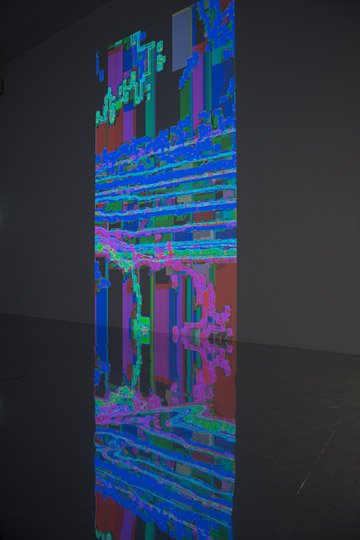
Tina Frank / Peter Rehberg, 20160815V, 2016/17
Floor mirror, HD video, color, sound, 3 min.
Courtesy the artists
photo: Markus Krottendorfer
The artist and designer Tina Frank (*1970 Tulln, lives in Vienna) plays with the experimental visualization of music. Early on, she utilized digital media, glitch, and distortion to create packaging for LPs and CDs of experimental music, as well as interfaces and websites. Frank regularly collaborates with musicians and designs digital landscapes to their electronic compositions. In 20160815V, Frank developed digital patterns to music by Peter Rehberg (*1968 London, lives in Vienna) that interrupt the high-definition megapixels of digital graphics. Frank and Rehberg explicitly counteract an HD digital world with noise and pixelated images, sudden breaks, and strong contrasts. Analog references, like the test image at the beginning of videotape, underline their approach of opposing granular authenticity and digital flatness. The mirrored floor, which is part of the installation at the Künstlerhaus, heightens the immersive qualities of Frank and Rehberg’s electronic world of image and sound, defining the video as ambience and leading to further distortions.
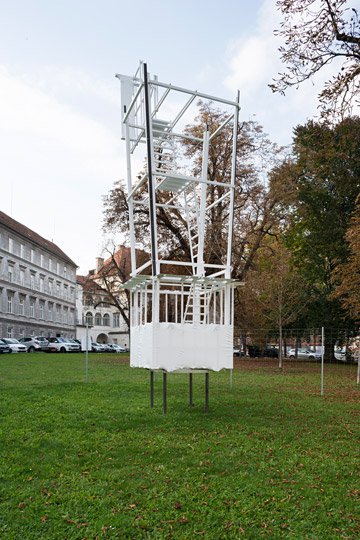
Ludovica Carbotta, Monowe (the terminal outpost), 2017
Wood, iron, heat-shrink wrap, plywood, wire cable, plexiglas, 825 x195 x 317 cm; Project executive: orizzontale, Rome; Commissioned by Künstlerhaus –Halle für Kunst & Medien
Courtesy the artist and Galerie Marta Cervera, Madrid
photo: Markus Krottendorfer
The starting point for Ludovica Carbotta’s (*1982 Turin, lives in Maastricht) work is the interactionof individuals in urban landscapes and their surrounding environment. The artist’s installations, texts, and performances deal with concepts of identity and communication, blurring the lines between fact and fiction. Monowe (the terminal outpost) is yet another chapter of her ongoing project of the same name, a fictional city set in the future built for only one person. A watchtower, situated at the periphery of the exhibition’s outdoor space, enables the inhabitant to patrol the city’s borders. Yet, built upside down, it exposes its own paradoxical function: The watchtower provides the overview of a city that has neither visible nor concrete borders. In respect of current political efforts to enforce mass-surveillance in public places as well as the re-establishment of border controls, Carbotta’s work can be considered a call fornew forms of communality.

Tobias Putrih, Double Exchange, 2017
Two stacks of bricks, one red, one grey, each placed on four wood palettes, dimensions variable
Commissioned by Künstlerhaus – Halle für Kunst & Medien
Courtesy the artist
photo: Markus Krottendorfer
Instructions:
Take one red brick and place it on the stack of grey bricks. Then, take one grey brick and place it on the stack of red bricks Slovenian artist Tobias Putrih (*1972 Kranj, lives in Cambridge, Massachusetts, and Ljubljana) creates large-scale works that reference the utopias and ideologies of the classical avant-garde. Architectural and design histories, as well as sociological theories build the basis of his artistic enquiry. In the past few years, the artist investigated concepts of game theory that he then presented in varying interactive installations. In Double Exchange, seemingly constructivist formations emerge through the transference of red and grey bricks, recalling, at times, architectural ruins, sculptures midproduction, or skylines of distant cities.

Clemens Hollerer, The Locust, 2017
Lacquer on wood, dimensions variable; Commissioned by Künstlerhaus –Halle für Kunst & Medien
Courtesy the artist
photo: Markus Krottendorfer
Since 2008, the Styrian artist Clemens Hollerer (*1975 Bruck/ Mur, lives in Bad Gleichenberg) creates complex, sculptural environments and encompassing installations based on research revolving around catastrophic scenarios. Made from wooden laths and covered in lacquer, Hollerer’s practice is site-specific, therefore creating an explicit relationship between the work and the site of its exhibition. Graz’s city park, a space of thriving flora and fauna, is the starting point for The Locust. The central aspect of the installation is its connection to nature. Industrially produced wooden laths painted telemagenta, an obviously artificial color, are in direct opposition to the natural material of its host, the tree. The rough structure of the tree bark collides with the slick shine of the lacquercoated wooden laths. In Hollerer’s work, treated and untreated materials adapt to one another, becoming an artistic entity despite their differences. Similarly, the locust, which is also the title of the piece, is confronted with difference. A nomadic insect, the locust must continuously deal with changing environments to survive. Often considered to have a negative effect on the environment, the work connotes the destruction of common habitats.
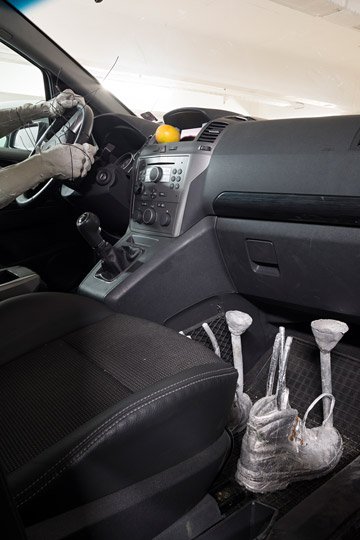
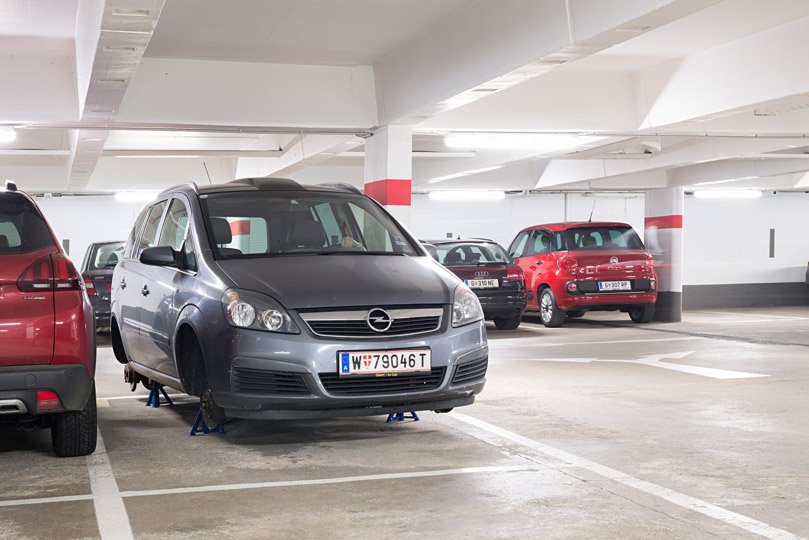
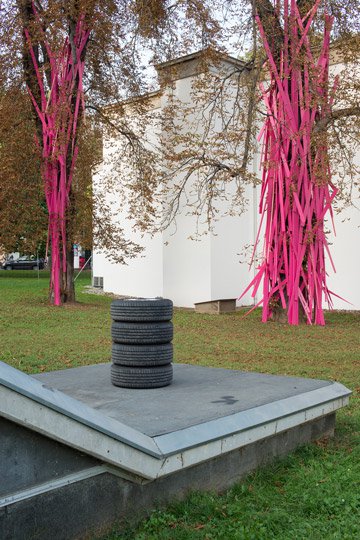
Hans Schabus, Auf der Suche nach der endlosen Säule (Graz), 2017
Car tires, car, car jacks, concrete, aluminum, wood, packing blanket, apple, map, 88 x 63 x 63 cm and 167 x 180 x 447 cm, Comissioned by Künstlerhaus –Halle für Kunst & Medien
Courtesy the artist
This artwork has two parts: one is in the outside area of the exhibition and the other is on the lowest floor of the underground parking garage, level 2 (which can be accessed at various points outside of the exhibition area). Many of Hans Schabus’ (*1970 Watschig, lives in Vienna) works are based on physically and psychologically strenuous, off-beat expeditions, in which he explores different types of spaces against all odds. For example, Schabus’ sailed through a sewer system, dug a hole from his studio deep into the ground in Vienna, or traveled from the West to the East coast of the U.S. on a racing cycle. In trigon 67/17, Schabus’ once more tackles the Endless Column by Romanian sculptor Constantin Brâncući (*1876 Hobića, †1957 Paris). In 1937, in the Romanian town Târgu Jiu, Brâncu?i called his vertical sculpture, made from identical, stacked elements, “a latter to the heavens”. As an indirect reference to Brâncući’s looming object, Schabus has placed stacked car tires on the roof of the stairwell to the underground parking garage, thereby also pointing to the uncoupled stateof the artist’s car parked below. As a result, the jacked up car becomes itself a vitrine, a sculptural deliberation on movement and stasis, questioning the spatial entanglement of inside and outside, up and down.
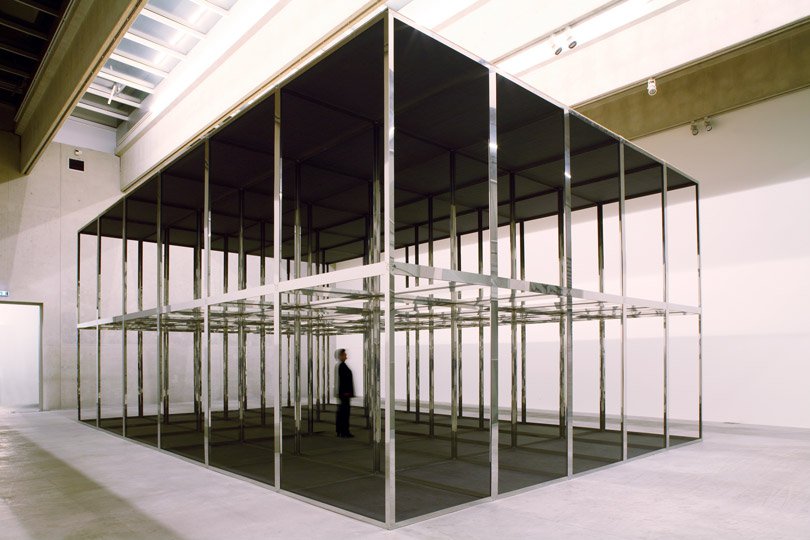
Markus Wilfling, Spiegelkabinett, 2007
Nirosta, aluminum, 450 x 1170 x 740 cm
Courtesy the artist
photo: Christian Redtenbacher
The works of sculptor Markus Wilfling (*1966 Innsbruck, lives in Graz) humorously grapple with the history of sculpture. By embedding everyday objects in unusual environments, dislodging their functions, he deliberately heightens our awareness of the object. Bathtubs disappear into the ground; park benches protrude out over steep slopes. The artist also uses reflection and shadow in connection with architecture to subtly disrupt our perception. For example, his Spiegelkabinett (Hall of Mirrors) is an accessible, monumental structure made up of multiple rows of same-sized (mirror) frames. Yet the actual mirrors are missing. Instead the frames themselves reflect their surroundings und create the impression of mirroring walls. Together, these factors lead to an uncertainty of our spatial perception, undermining the exact location of the body within the surrounding structure.

Rosa Barba, Free Post Mersey Tunnel, 2010
Pipes, sound, dimensions variable
Courtesy the artist
photo: Markus Krottendorfer
The German-Italian artist Rosa Barba (*1972 Agrigent, lives in Berlin) is mainly known for her investigation of the medium film. Barba’s work oscillates between documentary and fictive practices, revolving around the construction of cinematic spaces as well as time within film. Conceptually, her work examines the conditions, grammar, and materials of cinema. In addition, Barba addresses the relationship between space and film by exposing the cinematic apparatus; thus, the work can be seen from a sculptural perspective. Shown for the first time at the Liverpool Biennale in 2010, the sound installation Free Post Mersey Tunnel expands the traditional definition of sculpture. Sounding out from meandering, labyrinth-like metal pipes, we hear the noise of street traffic and the buzzing of a ventilator system. The artist recorded these sounds in a ventilation shaft under the highway in Liverpool that guides traffic through a tunnel under the river Mersey. The spatial situation at the Burgring, the underground parking garage and the position of the Künstlerhaus allows for the seamless transfer of this work from Liverpool to Graz.
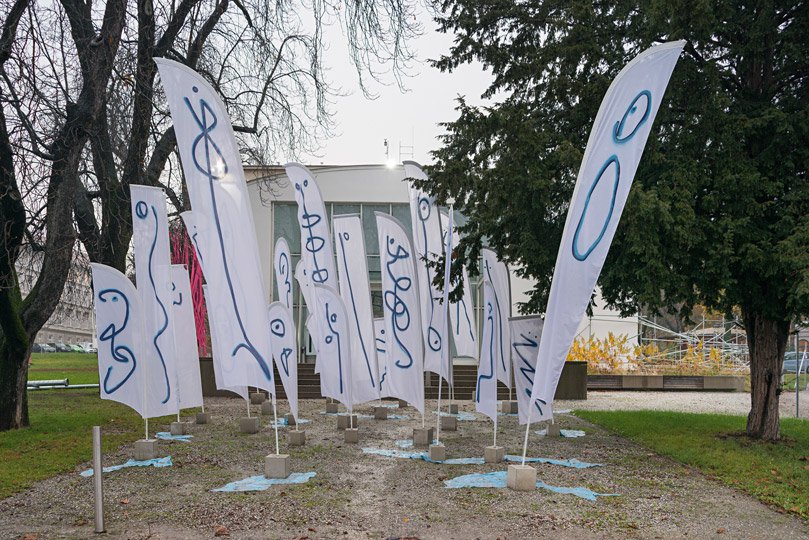
Flaka Haliti, Concerned by the ghost without being bothered, 2017
Banners, drop flags, bow flags, metal, digital print, spray paint, concrete, dimensions variable
Courtesy the artist and Deborah Schamoni, Munich
photo: Markus Krottendorfer
A fundamental aspect of Flaka Haliti’s (*1982 Priština, lives in Munich) artistic practice—besides the analysis of social conditions and the media—stems from her personal experience of living in different cultures. The artist’s conceptual approach investigates ideas of feminism, capitalism, and imperialism. Countering the ubiquity of untethered cosmopolitanism common in the art world today, Haliti’s works address subjects of migration and displacement. Concerned by the ghost without being bothered is based on the book Specters of Marx (1993) by French philosopher Jacques Derrida, in which he
discusses the term of the specter, or ghost, a state of being that is not de facto present but is still felt. In the exhibition, these ghosts appear in the shape of various advertising banners, covered in blues lines and placed on blue ground, which is found nowhere else in trigon 67/17. As an assembly of ghosts, the work could be interpreted as a gathering, procession or demonstration.

Exhibition view section trigon 67, Basement floor, Künstlerhaus – Halle für Kunst & Medien
photo: Markus Krottendorfer
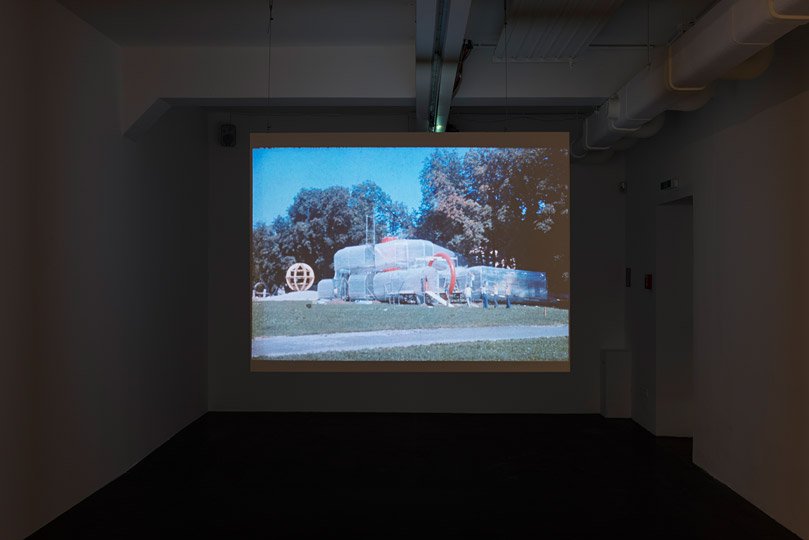
Eilfried Huth, Film footage trigon 67, 1967 Film, 8mm, color, silent, video transfer, 35:33 min.
Eilfried Huth, Photo documentation trigon 67, 1967
135 photographs
In the footage filmed by Huth during the installation and duration of trigon 67, the actions and events taking place around the Künstlerhaus were recorded. The entry situation is extensively shown in these sequences; and of particular prominence are the different colors of the works in the show. The documentation also enables a reconstruction of the spatial orientation of Jaki Jože Horvat’s (*1930 Murska Sobota – 2009 Nazarje) fantastical and surrealist paintings in the Künstlerhaus’ foyer. The Slovenian artist produced his works at the Künstlerhaus and presented them in portable frames covered from top to bottom with paint. Another highlight in Huth’s footage is the fashion show staged in trigon 67, commissioned by the Burda-Verlag. In accordance with the participatory intention of the exhibition, models posed on and in front of artworks. Vjenceslav Richter’s (*1917 Drenova – 2002 Zagreb)contribution was one of the backdropsfor the fashion show, even though his work was never fully finalized. Richter had planned to produce a cube made of glass pipingwith a 2.5 meter half-dome “cut” out from the center. Because production of this work was so complex, Richter’s concept couldn’t be realized in actuality. In the end, the alternative proposal, made from cement, didn’t work out either.
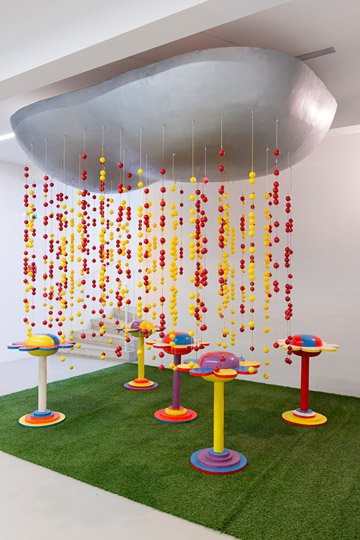
Miroslav Šutej, Rain Environment, 1967/2013
Diverse materials, dimensions variable
Courtesy Neue Galerie am Universalmuseum Joanneum, Graz
In the 1960s, Croatian artist Miroslav Šutej (*1936 Duga Resa – 2005 Krapinske Toplice) gained traction for his works that played with optical effects, suggesting volumes, proximity, and distance. The artist’s transition to object-based art was initially inspired by simple geometric forms like cyclinders and half circles, he then increasingly created concepts for environments. The first work to be realized, thus moving beyond a conceptual sketch, was Rain Environment, an artificial setting shown in a side gallery in trigon67. Šutej covered the gallery’s ceiling with a cloud made of blue plastic; densely hung, yellow and red, painted ping pong balls strung on cords represented rain. The floor was covered by green carpet anddecorated with five, colorfully painted wooden flowers and the walls were covered with a metallic foil. Besides visual enjoyment, Šutej’s allegory of nature had explicit haptic qualities.

Drago Tršar, Study for trigon 67, 1967
Quill, black ink, scumbled
Courtesy Neue Galerie am Universalmuseum Joanneum, Graz
photo: Markus Krottendorfer
Drago Tršar (*1927 Planina, lives in Ljubljana), known for his abstract sculptures, is one of the most significant, modern Slovenian artists. After studying at the art academy in Ljubljana, he became an assistant professor in 1961 and then professor in 1967. In the exhibition trigon 67, visitors encountered Tršar’s contribution immediately after passing through the “entry transformer” designed by Günther Domenig (*1934 Klagenfurt – 2012 Graz) and Eilfried Huth (1930 Pengalengan, lives in Graz). Tršar’s work was comprised of six concrete pipe elements, commonly found in the construction of silos, arranged as a pyramid. They had the same diameter but had different depths. The three, lower pipes were cut in half, and therefore only partially protruded over the lawn of the outside area. One of the two pipes in the middle level had 40 cm high, pyramid shaped chunks cut out, recalling teeth. The upper pipe element had the least depth. In the catalog, Tršar said the following about his monumental sculpture: “I gave myself the task of balancing living and dead space, to determine fixed connections of both types and balance them, and to support contrast. The composition of space is unified by forming a pyramid, enabling collective growth.”
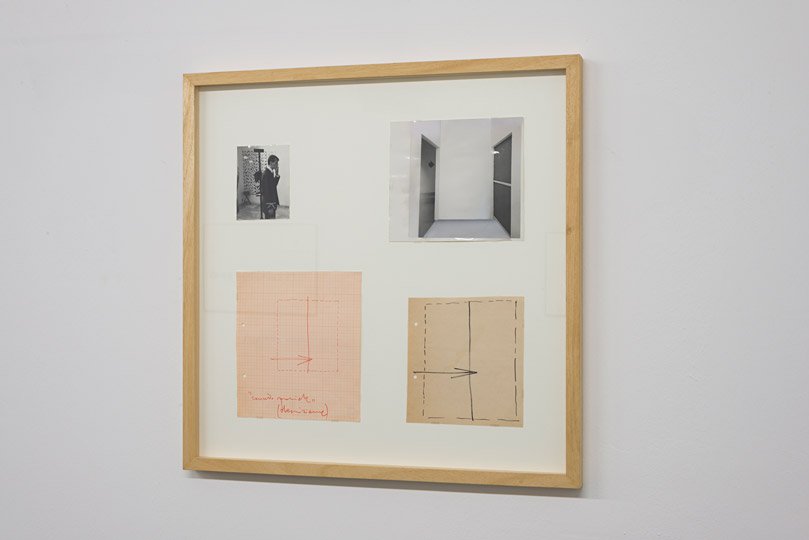
Luciano Fabro, Concetto spaziale, 1967
Photomontage, copy, millimeter, paper, felt pen, 9 x 11 cm, 18 x 20 cm, 22 x 20 cm,
18 x 17.5 cm
Courtesy Neue Galerie am Universalmuseum Joanneum, Graz
photo: Markus Krottendorfer
The Italian artist Luciano Fabro (*1936 Turin – 2007 Milan) is known for his space-encompassing installations and sculptures made from natural, “poor” materials. He was one of the six artists, who in September of 1967 were shown in the exhibition Arte povera e IM spazio (Arte Povera and IM Space), organized by the art critic and curator Germano Celant (*1940 Genua, lives in Milan). Fabro is therefore one of the central figures of Arte Povera. Just a few days before the exhibition opened in Genua, Fabro presented his empty, white, and illuminated cube in the interior space of the Künstlerhaus. The only visible, structural elements were the lighting pipes and two samesized doorways. Fabro’s initial concept for the work connected two identical rooms, the second room blocked by a canvas seen from the back. Therefore, the space could not be visually experienced but only speculatively imagined, merging perception, reflection, and realization in one minimalist installation.
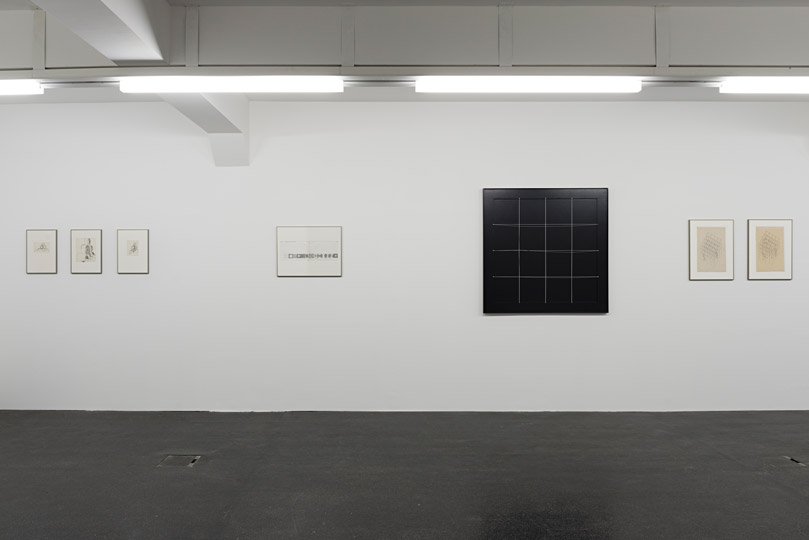
Enzo Mari, Ohne Titel, 1967
Felt pen on carbon trace paper, tape, 21 x 59.4 cm
Courtesy Neue Galerie am Universalmuseum Joanneum, Graz
photo: Markus Krottendorfer
In his works, the Italian artist and designer Enzo Mari (*1932 Novara, lives in Milan) grapples with questions of perceptual psychology. In 1952, he opened his design studioin Milan, where he worked for more than sixty years. His body of work includes objects, furniture, and ceramics, as well as games and books. Mari’s theoretical ideas mainly concentrated on the role of the designer and the object in everyday life. For his contribution to trigon 67, the idea of the “container” wascentral. Using thirteen identical boxes measuring 60 x 60 x 120 cm, the artist undertook an investigation in perceptual psychology of the relationship between container and the effect of space. The boxes were set up in a row at eye level. Visitors could look into them through one of the narrow sides. The interior walls of the cubes were colored either black or white, so that each cube affected the space differently. Thus, perception of the volume of space was influenced by the intensity of each hue and the relationships of the colored surfaces to each other.
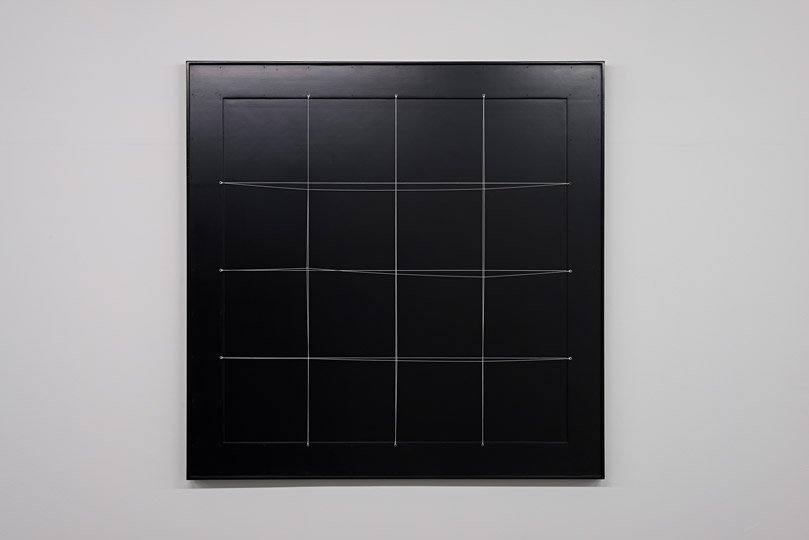
Gianni Colombo, Spazio elastico, 1974
Lacquered wood, elastic bands, nails, 125 x 125 x 3.35 cm
Courtesy Neue Galerie am Universalmuseum Joanneum, Graz
photo: Markus Krottendorfer
At the center of Gianni Colombo’s (*1937 Milan –1993 Melzo) artistic practice lies an investigation of optical phenomena. He is especially known for his kinetic environments and the deliberate use of light. The relationship to architecture and the surrounding habitat (Umraum) were of utmost importance to the artist. In his work Spazio elastico for trigon 67, he combined light, space, and movement in one work. Entering through special light doors, the viewer could explore a 3 x 3 x 3 meter cube. The interior was made up of an isometric network of elastic rubber tubes, the floor was covered with flat, recurring ramps. Rhythmic,fluorescent light signals exposed the space’s structure; touching the rubber tubes changed their spatial conditions. Thereby, Colombo created an ambience, effecting both the viewer’s balance and spatial perception.
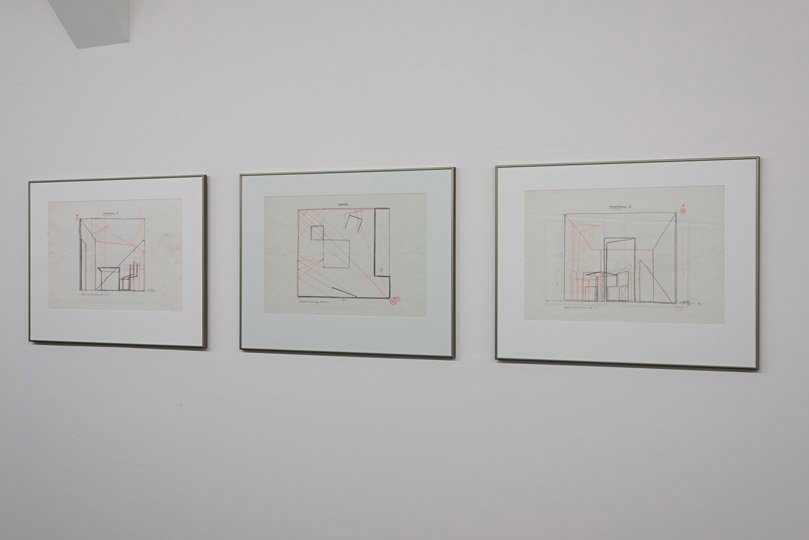
Giuseppe Uncini, Objekt mit Schatten, 1967
Black plastic, natural paper, Resopalsheet, 37.7 x 38 x 3.8 cm
Courtesy Neue Galerie am Universalmuseum Joanneum, Graz
Giuseppe Uncini, Study for trigon 67, Prospetto 1, 1967
Pencil, red pen, 48 x 66 cm
Courtesy Neue Galerie am Universalmuseum Joanneum, Graz
Giuseppe Uncini, Study for trigon 67, Prospetto 2, 1967
Pencil, red pen, 48 x 66 cm
Courtesy Neue Galerie am Universalmuseum Joanneum, Graz
Giuseppe Uncini, Pianta, 1967 Pencil, red pen, 48 x 66 cm
Courtesy Neue Galerie am Universalmuseum Joanneum, Graz
photo: Markus Krottendofer
Influenced by the material paintingsof the Informel movement, Italian artist Giuseppe Uncini (*1929 Fabriano – 2008 Trevi) began working in the 1950s, employing earth and sand instead of paint. In the following years, he belonged to the first group of artists that worked with cement and iron. These materials, characteristic for his overall practice, were commonly used in the building industry in the middle of the last century. Starting in themid-1960s, the artist focused on the investigation of space. Drawing on 1920s constructivism, Uncini created spaces defined only by their outlines, which he formed with aluminum bars. His “strutture spazio“ oscillate between drawing, sculpture, and architecture, and his key work Unità Cellulare, shown in trigon 67, helped define his sculptural terminology. Made up of orange, steel rods, this work traced the outlines of a life-size, furnished interior space. By using lighter colored rods he again traced the already existing forms, implying shadows. This meant that not only could the actual structure of the space be conceived but the virtual, in-between spaces constituted by the structure could be experienced as well. Since 2008, a reconstruction of Unità Cellulare can be seen in the Austrian Sculpture Park.
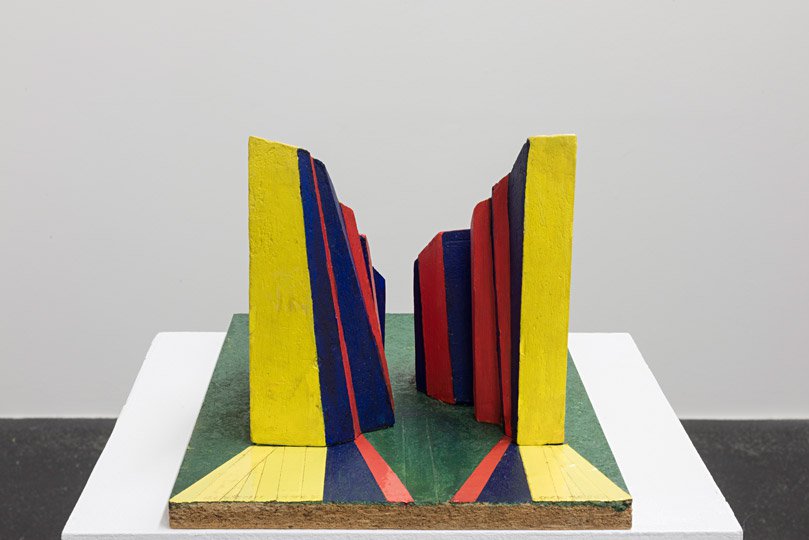
Roland Goeschl, Sackgasse (Model), 1967
Plaster, Novopan plywood sheet, Tixo tape, 27 x 39 x 20.2 cm
Courtesy Neue Galerie am Universalmuseum Joanneum, Graz
photo: Markus Krottendofer
Roland Goeschl (*1932 Salzburg – 2016 Vienna) was one of Austria’s formative sculptors. His architectural, spatial formations, influenced by constructivism, and his works inpublic space radically expanded the traditional notion of sculpture. A student of Fritz Wotruba (*1907 – 1975 Vienna), Goeschl began with a focus on the human body to then experiment with elementary forms and objects, and the primary colors blue, red, and yellow in the 1960s. Sackgasse (Dead end), shown in the outdoor area of trigon 67, is a key artwork in the artist’s oeuvre. The monumental, approximately fourmeter- high polyester object, was combined in such a way that every visitor who entered was inevitably experiencing a dead end. While the outside elements were painted yellow, the inside was painted blue and red, creating the impression of a vertical fissure. The intense colors of the work stood in stark contrast to the classical facades of the buildings near the Burgring, the backdropfor the exhibition trigon.
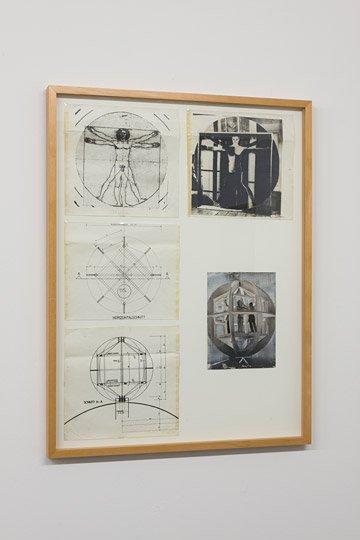
Mario Ceroli, Sketches for trigon 67, 1967
4 photocopies, 1 retouched photograph, 27 x 26 cm and 23 x 18 cm
Courtesy Neue Galerie am Universalmuseum Joanneum, Graz
photo: Markus Krottendorfer
In the 1960s, Italian artist Mario Ceroli (*1938 Castelfrentano, lives in Rome) gained a reputation for his silhouettes made of shaped wood. As an autodidact, Ceroli firstworked with clay before turning to untreated wood as his chosen material. In trigon 67, he presented a three-dimensionally expanded version of Leonardo da Vinci’s Vitruvian man, in the middle of the park next to the Künstlerhaus. The silhouette of this ideally proportioned human figure was embedded in a wooden globe that was four meters in diameter. Hinges allowed the arms to move. The open structure of the globe enabled the viewer’s gaze to fall on the surroundinglandscape, but its prominent position also made it subject to multiple and harmless “pornographic adaptations;” for example an oversized penis was affixed several times.
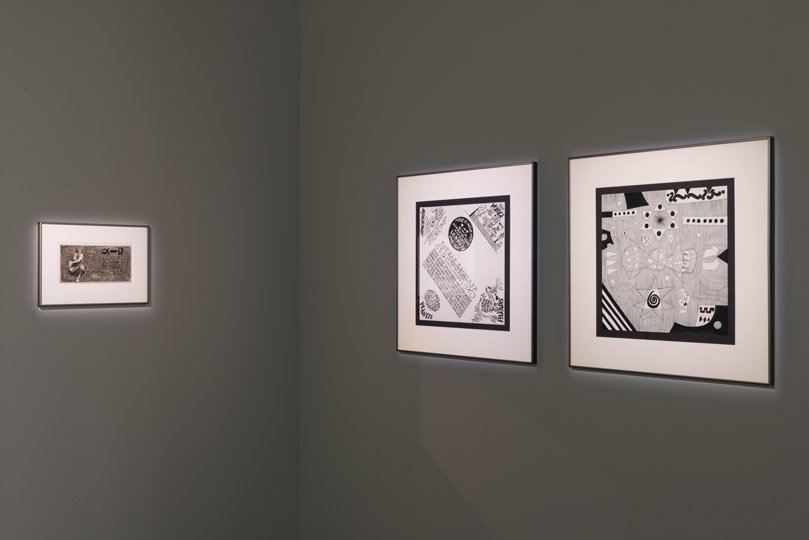
Rudolf Pointner, Alpha nach Omega, 1967
Steelplate engraving, etching, ink, 14.8 x 29.4 cm
Courtesy Neue Galerie am Universalmuseum Joanneum, Graz
Rudolf Pointner, Wir sind Reisende zwischen zwei Stationen, 1967
Ink, 44 x 44 cm
Courtesy Neue Galerie am Universalmuseum Joanneum, Graz
Rudolf Pointner, Von Stern zu Stern, 1967
Ink, 44 x 44.1 cm
Courtesy Neue Galerie am Universalmuseum Joanneum, Graz
photo: Markus Krottendorfer
The work by the autodidact Rudolf Pointner (*1907 Zadar – 1991 Graz) was influenced by folk art, non-European art, and Surrealism. His avant-garde ideas repeatedly brought the artist into conflicts; for instance, during the Nazi era, the Third Reich cultural administration forbade him to paint. In the 1950s, he turned to an informal practice. Exploring cultural forms from ancient South and Central America, Pointner ultimately developed an independent form of Surrealism defined by magical and esoteric elements. The obvious psychedelic influence that appeared in his works in the early 1970s had already been seen in the thirty-six oil paintings featured in trigon 67. In the side room, Pointner placed a square partition wall hung with paintings. More paintings were presented on the walls of the room, which were painted black. In accordance with the title of his piece Wir sind Reisende zwischen zwei Stationen, Reisende von Stern zu Stern (We are travelers between two stations, journeying from star to star), the painting symbolically tells the story of passengers who are brought by helicopter to a departure point on Earth. They then travel on a spaceship to a star, and finally, to another star on another spaceship.
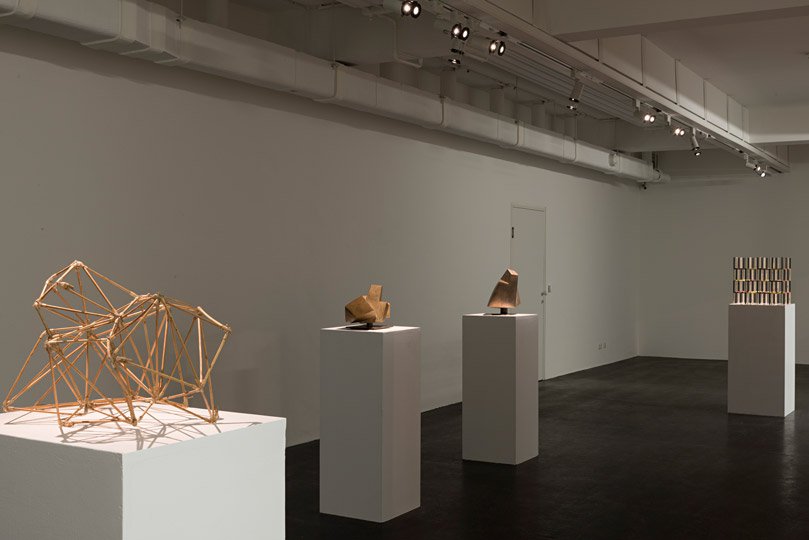
Josef Pillhofer, Vogel I, 1958
Bronze, Courtesy Susanna Tabaka-Pillhofer, Vienna
Josef Pillhofer, Vogel II, 1967/70
Bronze, 25 x 24 x 36 cm
Courtesy Neue Galerie am Universalmuseum Joanneum, Graz
Josef Pillhofer, Ohne Titel (Modelltrigon 67), 1967
Wood, plastic, cords, 40 x 36 x 60 cm
Courtesy Susanna Tabaka-Pillhofer, Vienna
Josef Pillhofer’s (*1921 – 2010 Vienna) sculptural work is defined by the dissolution of the human body into geometrical figures. As a student, the artist discovered Cubism for himself. During a stay in Paris, where he met the artists Constantin Brâncuși (*1876 Hobița – 1957 Paris) and Henri Laurens (*1885 Paris – 1954 Paris), he was able to expand his knowledge. Pillhofer worked with traditional materials such as bronze, wood, stone, and iron, preferably in a smallformat. His monumental, outdoor sculpture for trigon 67, based ona model about forty centimeters in height, is of an abstract form of a bird. With help from a locksmith, Pillhofer ultimately developed a five-meter-high scaffold structure made out of six prisms inscribed with six tetrahedrons. Lastly, the entire structure was painted white. This gave a special emphasis to both the exterior shape and the interior structure of the work.
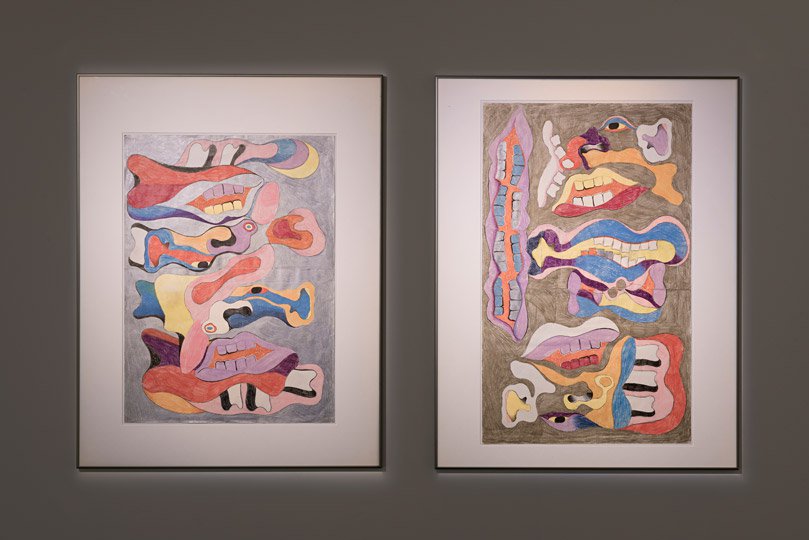
Oswald Oberhuber, Entwurf für trigon, 1967
Collage, offset print, 35 x 25 cm
Courtesy Neue Galerie am Universalmuseum Joanneum, Graz
photo: Markus Krottendofer
With his heterogeneous works ofart, Oswald Oberhuber (*1931 Meran, lives in Vienna) opposes the idea of the concise work marked by an individual style. In the 1950s, for example, he made informal sculptures, but in the late 1960s he turned to conceptual art. His environment in trigon 67 wasan eight-meter-high tower with a diameter of four meters, which could be accessed from the apsis via a tube leading out of the Ku?nstlerhaus. Inside this tower visitors were confronted with an oversized face. At the entrance—a large mouth—one had to pass by a tooth-like object before stepping onto a red tongue. The interior cylinder of the tower was designed in a surrealistic, fantastical style, with facial features. The artist described his strongly psychedelic work as follows: “It was a face turned insideout—very funny, gigantic, pop.” Oberhuber would have liked to have used more technology, such as moving walls, but unfortunately, there was no funding left over for that.

Jorrit Tornquist, Colorful structure (Model), 1967
Wood, paint, 43 x 43 x 43.5 cm
Courtesy Neue Galerie am Universalmuseum Joanneum, Graz
photo: Markus Krottendorfer
As a member of Forum Stadtpark (founded in 1959), the Austrianartist Jorrit Tornquist (*1938 Graz, lives in Bergamo) was a culturally formative figure in the progressive movements in 1960s Graz. The artist’s practice revolves around the relationship between color, surface, and space in the medium painting as well as architecture. For most of his life, the investigation of color played a major role. Taking part in trigon 67 enabled Tornquist to realize a large-scale scientific, mathematical model he had developed in the years before. This model was based on the assumption that human perception can be dissected into individual components. He used a grid as a means of visualization. In the exhibition, Tornquist displayed a 2.5 x 2.5 x 2.5 meter lattice-structure comprised of various colored piping. By alternating lighting in accordance with the color of the painted pipes, he aspired to let some parts seem “invisible.” In doing so, it is possible to experience dimensions of space and time. In the accompanying catalog Tornquist presented his ideas in utmost detail in the form of a color chart that encompassed five pages of descriptions (orientation, color, movement, proportion) and another five pages of instructions (medium, color, proportion).
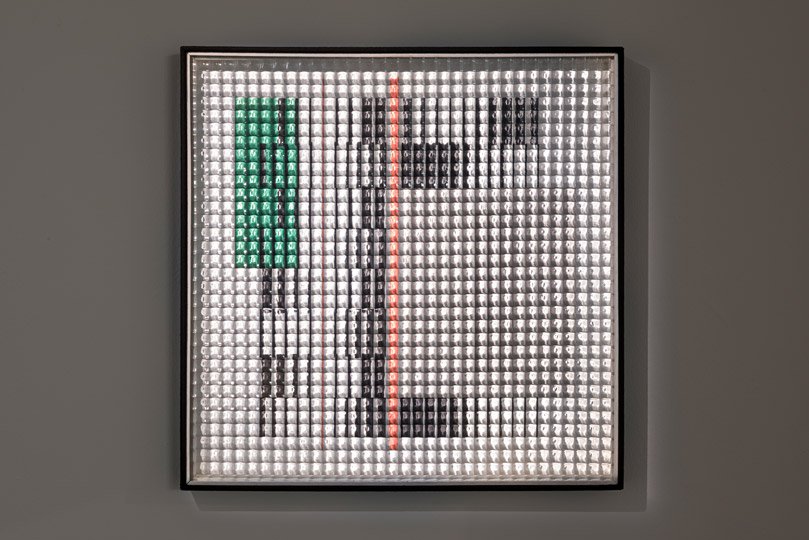
Marc Adrian, H3, 1967
Oil on wood, ribbed glass (reverseglass mounting), 61.5 x 61.5 cm
Courtesy Neue Galerie am Universalmuseum Joanneum, Graz
photo: Markus Krottendorfer
The artist Marc Adrian (*1930 – 2008 Vienna) belongs to the firstgeneration of Austrian artists working in avant-garde film. He is known for extending the fields of paintingand sculpture into the filmic medium and playing with optical phenomena. In 1967, he turned the Künstlerhaus’ apsis into a black box equipped with irregularly placed cushions and pads on the floor and walls. This “Raumkunstwerk,” as Adrian called it, also exhibited projections of erotic film scenes on rotating mirrors. In addition, the visitors were given instructions by the artist, who read a German text titled “interventionist mediation,” played on an accompanying audiotape:“[…] Take four steps forward and bend your body to the left. Close your left eye precisely and quickly and don’t be shy. Remember your left leg and recount something obscene four times. Stay calm and think about something. Perform everything you hear quickly and precisely. Don’t be shy. Describe the arranged optical situation as a result of the multiplication four times four. Marc Adrian’s voice is talking to your upper body. Bend slightly forward…[…].“
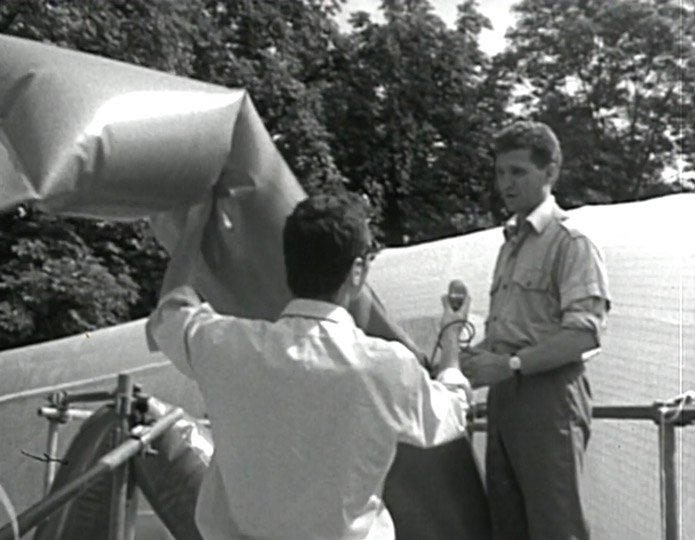
Ferry Radax, Trigon Graz, 1967
Film, 16mm, B/W, sound,video transfer, 157 min.; Camera: Karl Spindler; Sound: Adolf Pascher, Willy Buchmüller; Music: Erich Kleinschuster + Sextett; Production Assistant: Viktor Matouschek, Art Direction: Ferry Radax
Commissioned by the then vicedirector of the Styrian cultural bureau, Hanns Koren, the avantgarde filmmaker Ferry Radax (*1932 Vienna – lives near Krems) was hired to produce a documentary, covering the entire exhibition trigon 67. In the film, Radax humorously follows the architects Domenig and Huth, as well as artists showing in the exhibition, and impersonates an investigative journalist, who asks provocative questions. For comic relief, Radax continually refers to the quarrel between the curator Wilfired Skreiner and the artist Roland Goeschl, who were arguing about the funding of Goeschl’s monumental work, Sackgasse (Dead end). Ferry Radax managed to bestow this documentary with his own individual and artistic style, and its significance as an (art) historical source is immense.
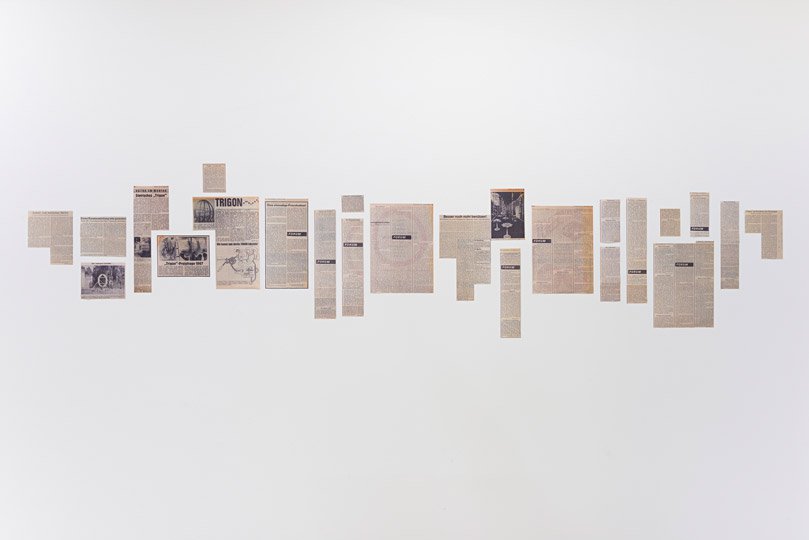
Wall of press clippings from trigon 67, photo: Markus Krottendorfer
